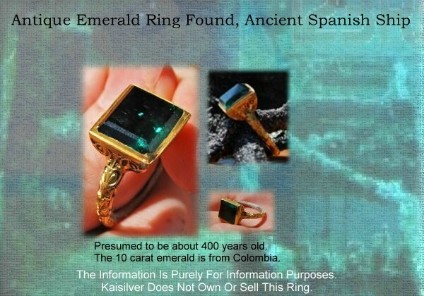Big Emerald Ring, Antique Emerald Gold Ring
A big emerald ring is salvaged from an ancient Spanish ship wreck. This emerald ring dates back to over 4 centuries, that was when the Spanish ship was hit by a terrible storm and went down the ocean. While the history and age of the large emerald gold ring is very exciting, Kaisilver experts have tried to analyze the condition of the big 10 carat emerald that was set in the antique gold ring. When most gem experts recommend that emeralds not be soaked in water for more than a few seconds, this big emerald gemstone ring lay at the bottom of the ocean for more than 400 years. The jewel will ofcourse carry a hefty price value of but, how did the gem really pull through this extreme soaking. In this Kaisilver report we analyze what might have happened to this emerald ring. At the same time we still continue to maintain that your emerald gem or emerald gemstone jewel should not, be soaked in water for more than 15 to 30 seconds. And even this should not be done too often, you will soon learn why.

Let us first explain why emeralds should not be soaked in water. From there we move on to what might have been the reasons for, the gem in this big emerald ring not being completely ruined. Emeralds are a variety of beryl, much like morganite or aquamarine but, this green beryl has some very specific physical characteristics that are worth noting. All emeralds have visible fissures and cracks, these occur over the millions of years that it takes for an emerald gem to form. Emeralds with fewer visible fissures whill obviously show higher transparency and lustre, this translates into a higher price tag for the gem.
You might find a small 4mm or 5mm emerald stone where the, natural fissures and breaks are not clearly visible to the naked eye. However once you talk about big emerald gems that, go beyond 2.5 to 3 carats, you will need to accept the fact that visible fissures and cracks will exist. It has been more than a few centuries that, man learnt how to tackle the visibility factors of the fissures in natural emeralds. Natural oils are used to soak the emerald, these oils penetrate the stone and fill the gaps caused by the cracks. The oil treatment of emeralds helps reduce the visibility of the fissures and cracks, their appearance is softened. This increases the lustre and overall beauty of the gem, the stone obviously commands a better price.
The oil treatment for emeralds is accepted by all gem experts, infact you should take it for granted that any emerald stone or jewel that you buy will include a gem that is treated with oils. However newer treatments like colored resins and plastic fillings are not considered to be normal, they would infact reduce the value of the emerald. More importantly, any emerald treatment aside from the natural oil treatment needs to be disclosed to the buyer.
It is the oil treatment of emeralds that calls for some special care and handling of the gemstone. We already mentioned that almost all (over 98%) of the emeralds used in jewelry are treated with natural oils. Interestingly, it is the very low grade junk quality emeralds that are neglected and generally left untreated. When you soak an emerald in water, the same reaction as the oil treatment occurs on the stone. In this case the water seeps into the cracks and fissures - remember that you already have natural oils residing there now. The water could push the oils out of the fissures and cracks. This will ruin the beauty of the stone, something that could make your emerald appear dull and even lifeless.
What we can conclude is that the big emerald in the antique Spanish emerald ring shown on this page, would have also gone through the natural oil treatment. So how did the large 10 carat emerald in that antique ring stay in good condition after 400 years of soaking. The report on this ring did not state that the big emerald gem in the gold ring was damaged or damaged beyond repair. Though it is quite likely that this big emerald ring would have to be reconditioned, with cleaning and re-oiling of the stone, we can say is that no major damage was caused to the emerald.
This is what Kaisilver experts believe is the story behind this 'tough' emerald. The big emerald stone in this ring was cut from a high quality rough emerald stone, it does appear to be a Colombian emerald. Compared to the size of the stone, the density of cracks and fissures was quite limited. As a result of this, the beauty of the large emerald gold ring, did not depend much on the oil treatment provided to the gem. Infact you could say that, all the oil in the emerald would have come out of the stone in these 4 centuries. At the same time, professional jewelry experts will no doubt work to improve the beauty of the gem and give it another oil treatment dose. We would like to inform all readers that, such a high quality emerald is today almost impossible to find - you should therefore stick to the recommendation to avoid water soaking of your emerald gemstone ring.
You could get yourself a similar ring by, moderating the size and quality of the merald in the jewel. Depending on your budget, a 8x6mm, 9x7mm or even a 10x8mm size emerald could be used to craft your ring. Kaisilver will be glad to custom make the ring for you in gold or 925 silver with the gemstone of your choice. Our support team at sales@kaisilver.com will be glad to work specific price quotes for you based on your requirements. The complete report on this antique emerald ring can be reviewed at http://www.kaisilver.com/antique-emerald-ring-info-ks-201011.htm
